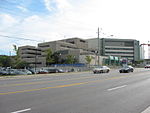Sacred Heart Catholic High School (Newmarket)
1979 establishments in OntarioAll Wikipedia neutral point of view disputesArt schools in CanadaCatholic secondary schools in OntarioEducation in Newmarket, Ontario ... and 4 more
Educational institutions established in 1979High schools in the Regional Municipality of YorkWikipedia neutral point of view disputes from May 2015York Catholic District School Board
Sacred Heart Catholic High School is a public Catholic high school in Newmarket, Ontario, Canada. It is currently the only high school in Newmarket under the jurisdiction of the York Catholic District School Board. There were 1620 full-time registered students for the 2005/2006 year, 95 full-time staff members, and 24 support staff.
Excerpt from the Wikipedia article Sacred Heart Catholic High School (Newmarket) (License: CC BY-SA 3.0, Authors).Sacred Heart Catholic High School (Newmarket)
Srigley Street, Newmarket
Geographical coordinates (GPS) Address Nearby Places Show on map
Geographical coordinates (GPS)
| Latitude | Longitude |
|---|---|
| N 44.058055555556 ° | E -79.44 ° |
Address
Srigley Street 866
L3Y 1R9 Newmarket
Ontario, Canada
Open on Google Maps





